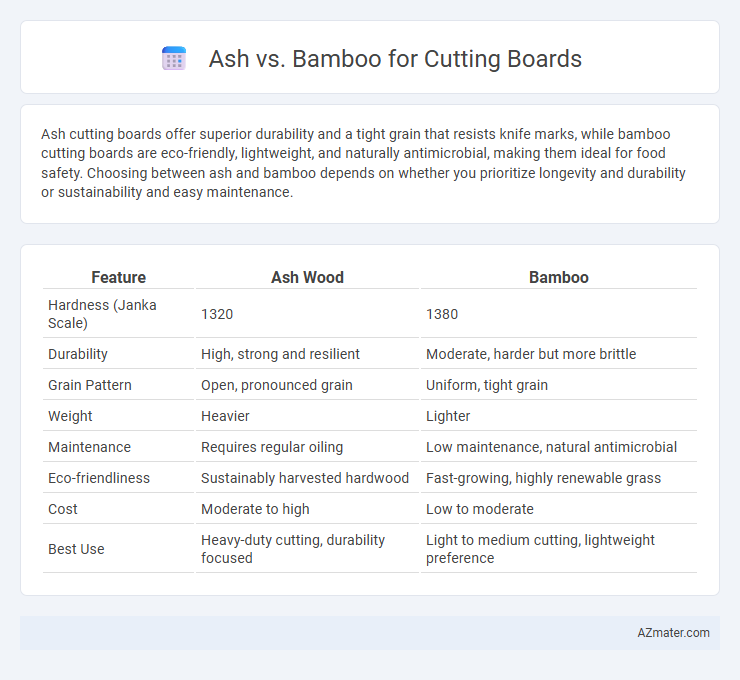Ash cutting boards offer superior durability and a tight grain that resists knife marks, while bamboo cutting boards are eco-friendly, lightweight, and naturally antimicrobial, making them ideal for food safety. Choosing between ash and bamboo depends on whether you prioritize longevity and durability or sustainability and easy maintenance.
Table of Comparison
| Feature | Ash Wood | Bamboo |
|---|---|---|
| Hardness (Janka Scale) | 1320 | 1380 |
| Durability | High, strong and resilient | Moderate, harder but more brittle |
| Grain Pattern | Open, pronounced grain | Uniform, tight grain |
| Weight | Heavier | Lighter |
| Maintenance | Requires regular oiling | Low maintenance, natural antimicrobial |
| Eco-friendliness | Sustainably harvested hardwood | Fast-growing, highly renewable grass |
| Cost | Moderate to high | Low to moderate |
| Best Use | Heavy-duty cutting, durability focused | Light to medium cutting, lightweight preference |
Introduction to Ash and Bamboo Cutting Boards
Ash cutting boards are valued for their durability, dense grain, and natural resistance to knife marks, making them ideal for heavy-duty kitchen tasks. Bamboo cutting boards feature a fast-growing, eco-friendly material with a hard surface that resists moisture and bacteria, promoting a hygienic food preparation environment. Both materials provide sustainable options with unique textures and maintenance needs, catering to different preferences in kitchenware.
Material Composition: Ash vs Bamboo
Ash cutting boards feature a hardwood composition known for its durability, natural antibacterial properties, and resistance to knife marks, making it ideal for heavy-duty kitchen use. Bamboo cutting boards consist of fast-growing grass fibers compressed into a sturdy, eco-friendly surface that resists moisture and warping while being lightweight and sustainable. Both materials balance hardness and knife preservation, but ash typically offers greater shock absorption and longevity in high-traffic culinary environments.
Sustainability and Eco-Friendliness
Ash wood cutting boards offer durability and natural resistance to moisture while being sourced from sustainably managed forests, making them an eco-friendly choice. Bamboo boards, made from fast-growing grass, provide a renewable and biodegradable alternative with minimal environmental impact due to their rapid harvest cycles and efficient land use. Choosing between ash and bamboo depends on balancing hardwood longevity with bamboo's superior renewability and lower carbon footprint.
Durability and Longevity Comparison
Ash cutting boards display remarkable durability due to their open-grain structure, which resists deep knife marks and warping over time. Bamboo boards excel in longevity because their dense, fibrous composition naturally repels moisture and resists cracking under heavy use. Both materials offer strong resistance to wear, but bamboo's eco-friendly hardness typically provides a longer lifespan with proper maintenance.
Knife-Friendliness and Blade Preservation
Ash cutting boards are renowned for their knife-friendly surface thanks to their moderately hard and open grain structure, which gently resists blade dulling while providing durability. Bamboo boards, though harder and more resistant to moisture and bacteria, tend to be more abrasive on knives, potentially causing faster blade wear over time. Choosing ash ensures better blade preservation with a softer cutting surface that maintains sharpness longer.
Maintenance and Cleaning Needs
Ash cutting boards require regular oiling with mineral oil to prevent drying and cracking, while bamboo boards are more resistant to moisture but benefit from occasional oiling to maintain smoothness. Both materials demand hand washing with mild soap and warm water, avoiding soaking or dishwashing to preserve longevity. Proper air drying in a well-ventilated area helps prevent warping and bacterial growth for both ash and bamboo cutting surfaces.
Resistance to Bacteria and Odors
Ash cutting boards feature a porous wood grain that can absorb moisture and bacteria more easily, increasing the risk of odor retention if not properly dried and sanitized. Bamboo cutting boards offer natural antimicrobial properties due to their dense, less porous surface, which resists bacteria absorption and helps minimize odor buildup over time. The hardness and tight fiber structure of bamboo make it more resistant to knife cuts that can harbor bacteria compared to ash, enhancing overall hygiene and longevity.
Cost and Availability
Ash cutting boards offer a cost-effective option with broad availability, making them popular in most kitchenware stores. Bamboo boards tend to be slightly more expensive due to sustainable harvesting practices but are widely available online and in specialty shops. Both materials provide durable surfaces, though ash is generally favored for budget-conscious consumers without sacrificing quality.
Aesthetics and Kitchen Style
Ash cutting boards feature a light, creamy color with pronounced grain patterns that complement rustic and farmhouse kitchen styles, adding a natural warmth and texture. Bamboo boards offer a sleek, uniform appearance with a smooth surface and subtle, fine grain, perfectly suited for modern, minimalist, and eco-friendly kitchens. Both materials provide distinct aesthetic qualities, with ash lending a traditional charm and bamboo enhancing contemporary kitchen decor.
Pros and Cons: Ash vs Bamboo Cutting Boards
Ash cutting boards offer excellent durability and natural shock absorption, making them resistant to knife marks and warping, while their open grain structure allows for better air circulation and drying. Bamboo cutting boards are eco-friendly, lightweight, and harder than many hardwoods, providing a dense surface that resists bacteria and scratches but can be more prone to cracking without proper care. Ash requires regular oiling to maintain its integrity and moisture resistance, whereas bamboo demands less upkeep but may dull knives faster due to its hardness.

Infographic: Ash vs Bamboo for Cutting Board
 azmater.com
azmater.com